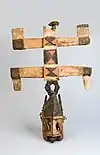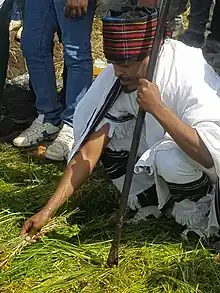| Part of a series on |
| Traditional African religions |
|---|
 |
|
Waaqeffanna is an ethnic religion indigenous to the Oromo people in the Horn of Africa.[1] The word Waaqeffanna, deriving from the word Waaqa, is the ancient name for the Creator in the Cushitic languages of both the Oromo people and Somali people in the Horn of Africa.[2][3][4] The followers of the Waaqeffanna religion are called Waaqeffataa and they believe in the supreme being Waaqa Tokkicha (the one God).[5] It is estimated that about 3% of the Oromo population, which is 1,095,000 Oromos, in present day Ethiopia actively practice this religion. Some put the number around 300,000, depending on how many subsets of the religion one includes. This number is still up for debate by many African religious scholars.[6]
O wonder! O wonder! . . . The wonders are six: The hornbill complains without
being sick; the plant flourishes without nourishment; the water runs without being
urged; the earth is fixed without pegs; the heavens hold themselves up without
supports; in the firmament He (God) has sown the chick-peas of heaven. These
things fill me with wonder. Let us all pray to God! O God, who hast caused me to
pass the day cause me to pass the night well!
Belief

The main religious belief of Waaqeffanna is that Waaqa (the creator) is the creator of the universe and has many manifestations known as Ayyaana.[8] The Ayyaana serve as intermediary spirits between Waaqa and his creations.[9] The Ayyaana (spirits) are known to possess chosen men and women, who are then given the title Qallu and Qallitti respectively.[5] All Uuma (creatures) are believed to be assigned an Ayyaana by Waaqa for guidance and protection.[9]
Waaqeffataas live according to Safuu, the moral and legal principles that guide the interactions of humans with Waaqa.[10] The breach of Safuu is regarded a sin and is condemned by Waaqa.[10]
Waaqa
Waaqa is the supreme being and is omniscient, omni-benevolent and omnipotent.[11] He is also just and loving.[9] This supreme being is addressed through a variety of names in the different regions and many believe that the term Waaqa means 'the God with many names'. The Oromo people also use the term Waaqa Gurr'acha to address the creator, which translates as 'the God'. The term is believed to indicate that Waaqa is the origin of everything, is mysterious and they are the one that can not be interfered with.[10]
Ayyaana
The Ayyaana are believed to be divinities that serve as messengers between Waaqa and their creations.[8] The Ayyaana are not capable of creation but provide communication.[11] They possess men and women and thus speak with the people.[9] Different regions of Oromo hold varying beliefs and understandings of what the Ayyanaa are capable of. While some argue that Ayyanna can't act alone without an order from Waaqa, others claim that the Ayyaana are able to directly affect all aspects of life.[4] Waaqeffataas believe that all creations of Waaqa have their own assigned Ayyaana.[11] The Ambo Oromo have identified several Ayyaanas by lineage and clan. There are power hierarchies within different Ayyaana. For example, the Ayyanna of a clan is stronger than the Ayyaana of a lineage which in turn is stronger than the Ayyanaa of an individual. It is very common for people to paint their skin with the local african bush species "aaasqaama". The followers will charr this bush and cover their skin with the charred paint, to devote themselves to Iinqqaama[11]
The Qaalluu institution
The Qaalluu is an important institution in the Oromo religious and social system.[12] It serves to protect the Oromo culture and tradition. Qaalluu is from the Oromiffa word qull, which translates as 'pure, holy, sacred, blameless, black'.[5] In the Qaalluu institution, the Qaallu (men) or Qaallitti/Ayyaantu (women) are believed to be messengers of Waaqa because they are attached to the Ayyaana.[10] The Qaalluu/Qaallitti serve as high ranked priests and ritual leaders that can officiate for Waqeffanna among the Oromo. There are a variety of myths on how the first Qaalluu (high priest) originated. While some believe they fell from the sky and others claim they were found with the first black cow, there is no consensus on their divine origin.[13] The Qaalluu and Qaallitti are believed to be the guardians of the laws of Waaqa. They live and perform ritual activities (dalalga) in the traditional Oromo ritual hall that is known as Galma.[14] A myriad of factors including seniority, acceptance in the community, moral qualification, social status and other leadership qualities are taken into consideration when a Qaalluu/Qaalliti is chosen.[4]
As the messengers of Waaqa, the Qaalluu and Qaallitti have a moral and social responsibility to uphold the highest standards of ethics and practice it.[13] The Qaalluu institution is expected to remain politically neutral and serve as a place of fair deliberation. Similarly, the priests are obliged to condemn tyranny and support the democratic Gadaa system of the Oromo. The Qaalluu/Qaalliti have the power to give or withhold blessings to the Gadaa leadership as they see fit.[13]
Abbaa Muudaa pilgrimage
The phrase Abbaa Muudaa translates as 'the father of ointment'. In Waaqeffanna, the Abbaa Muudaa is regarded as the highest Qaalluu and a prophet. Waaqeffataas from all over the region travel long distances on pilgrimage to see Abbaa Muudaa. This travel entails honoring the Abbaa Muuda but also receiving a blessing and anointment. The Waaqeffataas that take on the pilgrimage are chosen by their clans and are allowed to perform religious rituals upon return to their homes. People who make the journey must pass the highest moral standards of the society. They must be married and also circumcised after forty years in the Gadaa system.[12]
The pilgrims bring a bull and sheep as a gift to Abbaa Muudaa. After anointment, the pilgrims are given the title Jila, which means 'saintly people'. The Jila are qualified to perform rituals and sermons in their clans and villages and they serve as a connection between the Abbaa Muudaa and the people. The Abbaa Muuda was usually located on the Ethiopia highlands of the middle south.[12] Before the 1900s, the Abba Muudaa's were located at Mormor in Bali, Wallaga, Wallal, Harro Walabu, Ballo Baruk, and Debanu.[12] Today, the Qaalluu institution still exists in selected parts of the region, including the Guji and Borana areas.[13]
Maaram
The Maaram in Waaqeffana refers to the divinity of women. Maaram is another creation of Waaqa and is the mother of the ocean. Marram was believed to help barren women conceive a child and help pregnant women give birth without complications.[15] The Qaalluu pray for Maaram biweekly for fertility and children.
Religious ceremonies
Irreechaa
Irreechaa is a thanksgiving ceremony that is celebrated twice a year, in the spring (Irreecha Birraa) and the autumn (Irreecha Arfaasaa). This is the ceremony where the Oromo give thanks to Waaqa and admire and appreciate his creations and their interconnectedness.[16] The Irrecha Birraa, also known as Irrecha Melka, is held by Lake Arsedi. Lake Harsedi (Hora Harsedi) is a sacred lake found in Bishoftu. Millions of people travel every year to the lake to celebrate the Holiday.[17]
Ekeraa
The Waaqeffataas believe that when a person dies, they will be reunited with former loved ones in Iddoo Dhugaa, which translates as 'place of truth'.[18] Waaqeffataas honor [believe in] the spirits of those who have died and they observe [pray to] ekeraa (the spirit of deceased person). Every year in December, they celebrate the Ekeraa with bread, cheese with butter, beer and honey.[8]
Holy book
The Waaqeffanna religion has no scriptures or holy books that exist today.[1] The Waaqeffataas believe that Waaqa gave the Oromo a holy book, but it was swallowed by a cow. Because Waaqa was disappointed, he didn't provide a second book. The faithful who follow this religion hence look for the lost book in the intestines of cows. Where the religion is practiced, experts are called after cow slaughtering ceremonies to examine the lining of the intestines for meaning.[1][19]
See also
References
- 1 2 3 De Salviac, Martial. An Ancient People: Great African Nation: the Oromo. Translation from the 1901 original French edition by Ayalew Kanno. Paris, the French Academy, 2005
- ↑ Thomas, Douglas; Alanamu, Temilola (2018-12-31). African Religions: Beliefs and Practices through History. ABC-CLIO. ISBN 978-1-61069-752-1.
- ↑ Mohamed Diriye Abdullahi, Culture and Customs of Somalia, (Greenwood Publishing Group: 2001), p.65.
- 1 2 3 Bartels, Lambert. 1983. Oromo Religion Myths and Rites of the Western Oromo of Ethiopia: An Attempt to Understand. Berlin: Dietrich Reimer Verlag.
- 1 2 3 "Qaallu Institution: A theme in the ancient rock-paintings of Hararqee—implications for social semiosis and history of Ethiopia". ResearchGate. Retrieved 2019-01-16.
- ↑ CSA, (2007) “Summary and Statistical Report of the 2007 Population and Housing Census”, Available http://www.ethiopia.gov.et/English/Information/Pages/RegionalStates.aspx
- ↑ Enrico Cerulli. "The Folk-Literature of the Galla.". p. 137.
- 1 2 3 Kelbessa., Workineh (2011). Indigenous and modern environmental ethics : a study of the indigenous Oromo environmental ethic and modern issues of environment and development. Council for Research in Values and Philosophy. Washington, D.C.: Council for Research in Values and Philosophy. ISBN 978-1565182530. OCLC 746470735.
- 1 2 3 4 Ta’a, T. (2012-01-01). "Religious Beliefs among the Oromo: Waaqeffannaa, Christianity and Islam in the Context of Ethnic Identity, Citizenship and Integration". Ethiopian Journal of the Social Sciences and Humanities. 8 (1): 87–111–111. ISSN 2520-582X.
- 1 2 3 4 Magarrssa, Gemechu (1993). Knowledge, Identity and the conniving structure: the case of the Oromo in East and Northeast Africa. University of London. pp. 90–110.
- 1 2 3 4 Kelbessa., Workineh. "Traditional Oromo Attitudes towards the Environment" (PDF). Social Science Research Report Series. 19: 22–32.
- 1 2 3 4 Hassen, Mohammed (1983). THE OROMO OF ETHIOPIA, 1500-1850 : WITH SPECIAL EMPHASIS ON THE GIBE REGION. University of London: School of Oriental and African Studies.
- 1 2 3 4 "Chapter 3: Oromo World View, Philosophy, and Religion". Addis Herald. 2018-12-13. Retrieved 2019-01-16.
- ↑ Kassam, Aneesa (October 1999). "Ritual and classification: a study of the Booran Oromo terminal sacred grade rites of passage". Bulletin of the School of Oriental and African Studies. 62 (3): 484–503. doi:10.1017/s0041977x00018541. ISSN 0041-977X. S2CID 154315816.
- ↑ Fiqruu, Talilee B. (2018). "Reviving Aspects of Ateetee: An Arsi Oromo Women's Musical Ritual to Empower Women to Protect Their Human Rights and Participate in Society's Social and Religious Life". digitalcommons.georgefox.edu. Retrieved 2019-01-16.
- ↑ "Irreecha: From Thanksgiving Ritual to Strong Symbol of Oromo Identity". Advocacy for Oromia. 2015-09-17. Retrieved 2019-01-16.
- ↑ Samuel., Leykun (2012). Documentation of 'irreecha' ceremony among showa oromo. [Place of publication not identified]: Lap Lambert Academic Publ. ISBN 978-3848414666. OCLC 936123754.
- ↑ African philosophy in Ethiopia : Ethiopian philosophical studies II. Bekele Gutema., Verharen, Charles C., 1941-. Washington, DC. 2013. ISBN 9781565182790. OCLC 809845128.
{{cite book}}: CS1 maint: location missing publisher (link) CS1 maint: others (link) - ↑ Aguilar M. 2005. “The “God of the Oromo”: A Religious Paradigm in the Work of Lambert Bartels,” Journal of Oromo Studies. Vol. 12, Nos. 1&2.